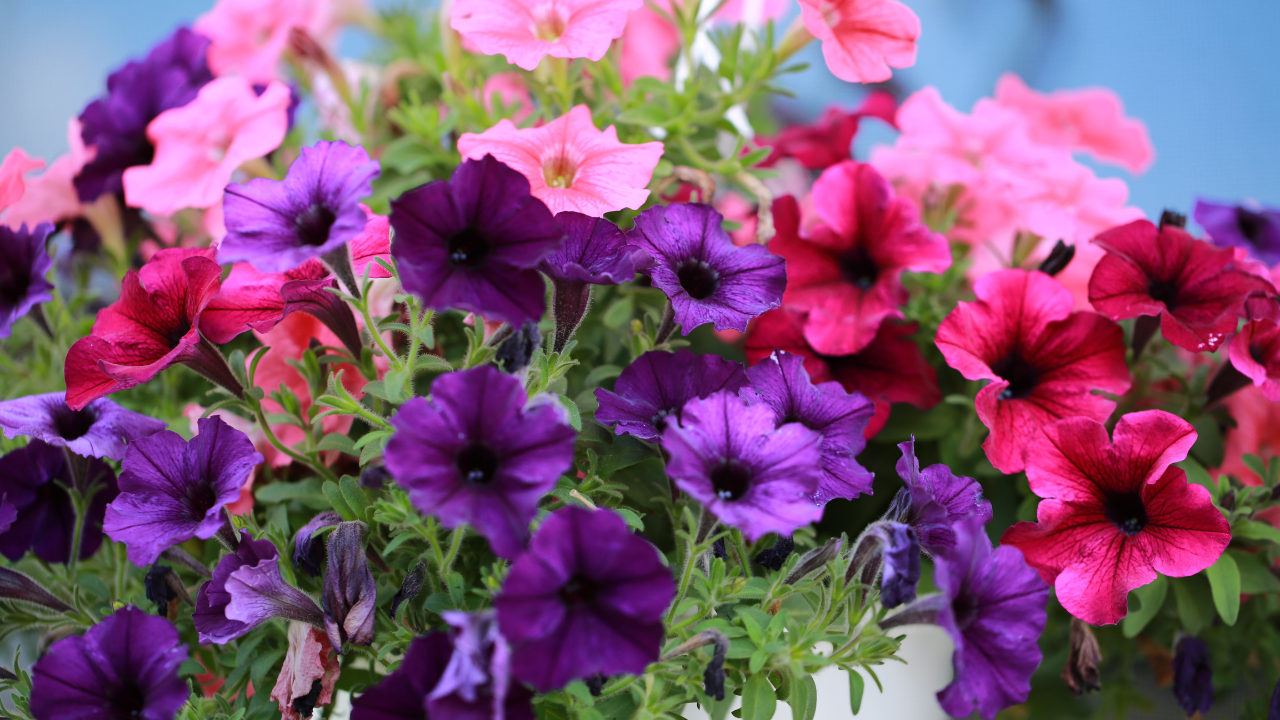Petunias, with their bright, trumpet-shaped flowers, add color and charm to any garden. While these hardy plants are relatively easy to grow, giving them the right care can make all the difference in ensuring they thrive throughout the season. For experienced gardeners, these ten petunia care tips will offer practical and specific guidance to help you get the best results from your plants.
1. Choose the Right Location
Petunias flourish in sunny spots, so selecting a location with at least six hours of direct sunlight daily is crucial. Ensure your garden bed or containers are positioned where they can absorb sunlight for most of the day. Although petunias can tolerate partial shade, they won’t produce as many blooms if they don’t receive enough sun.
When planting in containers, consider their placement to maximize sun exposure. Rotate pots occasionally to ensure all sides of the plant get equal sunlight. This helps to prevent leggy growth and encourages fuller, more abundant blooms.
2. Water Deeply but Infrequently
Petunias prefer deep watering rather than frequent, shallow watering. Water thoroughly when the top inch of soil feels dry, which encourages the roots to grow deeper and strengthens the plant. Consistent watering keeps petunias healthy, but avoid overwatering, as soggy roots can lead to rot and fungal diseases.
Water early in the day to allow excess moisture on the leaves to evaporate, reducing the risk of fungal infections. In containers, make sure drainage holes are sufficient to prevent water buildup, and never let the soil stay waterlogged for long periods.
3. Fertilize Regularly
Petunias are heavy feeders and benefit from regular fertilization throughout the growing season. Use a balanced, water-soluble fertilizer every two to three weeks to provide the necessary nutrients for continuous blooming. A slow-release fertilizer at planting can also give your petunias a strong start.
For container-grown petunias, fertilization is even more essential as nutrients leach out faster. Be mindful of overfertilization, which can lead to excessive foliage growth at the expense of flowers. Strike a balance to promote healthy, vibrant blooms.
4. Pinch and Prune for Fuller Growth
Pinching back the stems of young petunias encourages bushier growth and more flowers. By regularly removing the top few inches of growth, you can prevent the plant from becoming leggy and sparse. This practice helps distribute energy to side shoots, promoting a more compact, fuller plant.
Pruning spent blooms (deadheading) is another vital practice that redirects energy from seed production to new flower growth. Deadhead petunias weekly to maintain their aesthetic appeal and prolong the blooming period.
5. Provide Well-Drained Soil
Petunias need well-drained soil to thrive. If you’re planting in garden beds, amend the soil with compost or sand to improve drainage. Compacted or clay-heavy soils can suffocate roots, leading to poor growth or root rot. In containers, use high-quality potting mix that ensures both moisture retention and proper drainage.
Avoid using heavy garden soil in pots, as it tends to compact over time. The right soil balance is key—well-drained, but not too dry, ensuring the roots receive oxygen while staying adequately hydrated.
6. Monitor for Pests
Although petunias are relatively pest-resistant, aphids, caterpillars, and slugs can occasionally pose a threat. Inspect your plants regularly for signs of infestation. Aphids tend to cluster on new growth, while caterpillars and slugs will chew through leaves and flowers.
If you notice pests, act quickly by spraying with insecticidal soap or neem oil. For slugs, use organic slug baits or traps to minimize damage. Staying vigilant will ensure that your petunias remain pest-free and continue to flourish.
7. Mulch to Retain Moisture
Adding a layer of mulch around your petunias can help retain soil moisture and keep the roots cool during hot weather. Organic mulches, such as shredded bark or compost, are ideal because they decompose over time, enriching the soil. Aim for a 2-3 inch layer of mulch, ensuring it doesn’t touch the base of the plants to prevent rot.
Mulching also suppresses weeds, which compete with petunias for nutrients and water. This simple step will reduce maintenance and help your petunias stay healthy in the long run.
8. Space Plants Adequately
Proper spacing is essential for healthy petunias, as overcrowded plants compete for resources and are more prone to disease. Space trailing petunias about 12 inches apart and upright varieties about 8-10 inches apart, depending on the type. This allows for good air circulation, which reduces the risk of fungal issues like powdery mildew.
When planting in containers, ensure enough room for each plant to expand. Overcrowding leads to leggy growth and can hinder the plant’s ability to reach its full blooming potential.
9. Protect from Wind Damage
Petunias, especially trailing varieties, are susceptible to damage from strong winds. If you live in a windy area, plant your petunias in more sheltered locations or use stakes to support them. Windbreaks, such as nearby shrubs or fences, can also offer protection without blocking sunlight.
For container petunias, consider moving them indoors or to a sheltered spot during storms or particularly windy days. Minimizing wind exposure will keep the foliage and blooms intact, maintaining their overall health and appearance.
10. Rejuvenate Mid-Season with a Trim
Petunias can start to look tired by mid-summer, especially after a long period of continuous blooming. To rejuvenate your plants, give them a light trim by cutting back about one-third of the growth. This encourages fresh new growth and a resurgence of blooms in the later part of the season.
After trimming, follow up with fertilization and consistent watering to help the plants recover quickly. With this technique, you can enjoy vibrant petunias well into the late summer and early fall.

